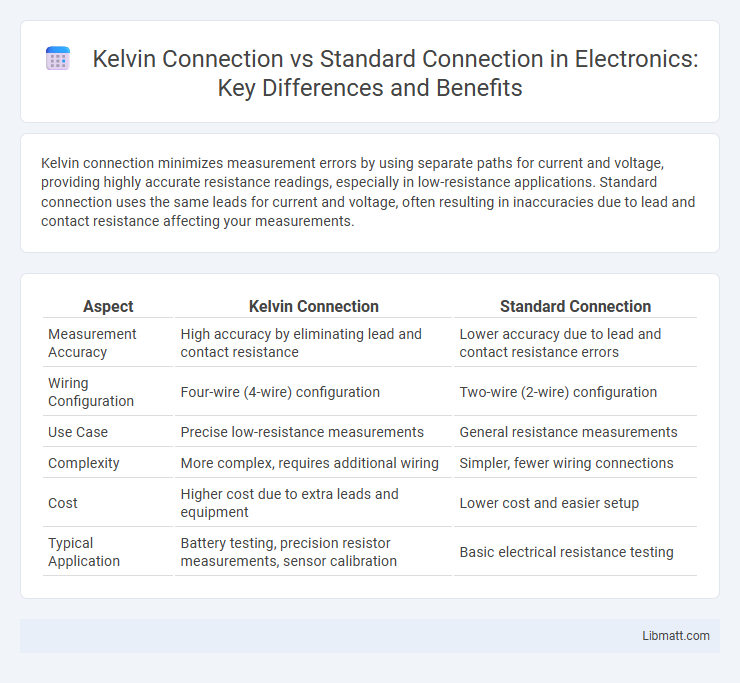Kelvin connection minimizes measurement errors by using separate paths for current and voltage, providing highly accurate resistance readings, especially in low-resistance applications. Standard connection uses the same leads for current and voltage, often resulting in inaccuracies due to lead and contact resistance affecting your measurements.
Table of Comparison
| Aspect | Kelvin Connection | Standard Connection |
|---|---|---|
| Measurement Accuracy | High accuracy by eliminating lead and contact resistance | Lower accuracy due to lead and contact resistance errors |
| Wiring Configuration | Four-wire (4-wire) configuration | Two-wire (2-wire) configuration |
| Use Case | Precise low-resistance measurements | General resistance measurements |
| Complexity | More complex, requires additional wiring | Simpler, fewer wiring connections |
| Cost | Higher cost due to extra leads and equipment | Lower cost and easier setup |
| Typical Application | Battery testing, precision resistor measurements, sensor calibration | Basic electrical resistance testing |
Introduction to Electrical Connections
Kelvin connection, also known as a four-wire connection, eliminates measurement errors caused by lead and contact resistance by using separate pairs of current and voltage leads. Standard connections typically employ two-wire setups where the same leads carry current and measure voltage, making them susceptible to inaccuracies in low-resistance measurements. You benefit from Kelvin connections when precise voltage sensing is critical, especially in applications involving low-resistance components or sensitive electrical instrumentation.
Overview of Kelvin and Standard Connections
Kelvin connection, also known as four-wire sensing, uses separate pairs of current-carrying and voltage-sensing leads to eliminate the effect of lead and contact resistance, providing highly accurate voltage measurements in precision applications. Standard connection, or two-wire sensing, combines current and voltage paths in the same leads, which can introduce errors in voltage readings due to lead resistance, making it less precise for low-resistance measurements. Understanding these differences helps you choose the appropriate method to ensure measurement accuracy in electrical testing scenarios.
Key Differences Between Kelvin and Standard Connections
Kelvin connections utilize separate pairs of wires for current flow and voltage measurement, eliminating lead and contact resistance from the voltage reading, which enhances accuracy in low-resistance measurements. In contrast, standard connections combine current and voltage paths in a single pair of leads, causing measurement errors due to voltage drops in the lead wires. Kelvin connections are essential for precise low-ohm resistance measurements in applications such as electrical component testing and battery analysis, whereas standard connections are sufficient for general-purpose measurements where precision is less critical.
Working Principle of Standard Connection
The working principle of a Standard connection involves directly measuring voltage and current through separate paths, where voltage is sensed at the load terminals while current flows through the conductor. This method often results in measurement inaccuracies due to voltage drops caused by the resistance of the test leads and contact points. Your measurements can be less precise compared to Kelvin connections, which use a four-wire method to eliminate these errors by separating current and voltage paths.
Working Principle of Kelvin Connection
The Kelvin connection operates by using separate pairs of current-carrying and voltage-sensing leads to eliminate errors caused by lead and contact resistances. This method ensures highly accurate resistance measurements, especially for low-resistance components, by preventing voltage drops in the current leads from affecting the voltage measurement. For precise readings in your projects, the Kelvin connection provides superior accuracy over the standard two-wire connection by isolating the measurement circuit from the current path.
Advantages of Kelvin Connection
Kelvin connection offers superior accuracy in low-resistance measurements by eliminating the effects of lead and contact resistances, ensuring precise voltage sensing directly at the test object. This technique significantly enhances measurement reliability in applications such as battery testing and precision resistors, where even minor resistance variations can impact results. By using separate current and voltage paths, your measurement system achieves enhanced stability and repeatability compared to standard two-wire methods.
Limitations of Standard Connection
Standard connections in electrical measurements often suffer from significant errors due to lead and contact resistance, which can distort voltage readings in low-resistance circuits. These limitations result in inaccurate current and voltage measurements, especially in precision applications where even minor resistance variations impact the results. Kelvin connections overcome these issues by using separate current and voltage paths, eliminating the influence of lead resistance and ensuring highly accurate measurements.
Applications of Kelvin Connection
Kelvin connection is widely used in precision measurement applications where accurate resistance or voltage readings are critical, such as in low-resistance measurements, strain gauge circuits, and four-wire sensing setups. This connection method minimizes the impact of lead and contact resistance, ensuring your measurements are highly accurate and reliable. Standard connections are more suited for general-purpose applications where extreme accuracy is not required.
Applications of Standard Connection
Standard connection is widely used in electrical systems where precise low-resistance measurements are not critical, such as in general-purpose resistance metering and basic circuit testing. It is suitable for applications involving low to moderate current values and environments where potential lead resistance does not significantly affect measurement accuracy. Common uses include household appliance testing, automotive diagnostics, and basic laboratory experiments.
Choosing Between Kelvin and Standard Connections
Choosing between Kelvin and Standard connections depends on the precision required in your measurements. Kelvin connections, also known as four-wire methods, eliminate the effect of lead resistance, providing highly accurate voltage readings in low-resistance or high-current applications. Standard connections, using two wires, are simpler but can introduce measurement errors due to resistance in the test leads, making them suitable for less precise or high-resistance scenarios.
Kelvin connection vs Standard connection Infographic

 libmatt.com
libmatt.com